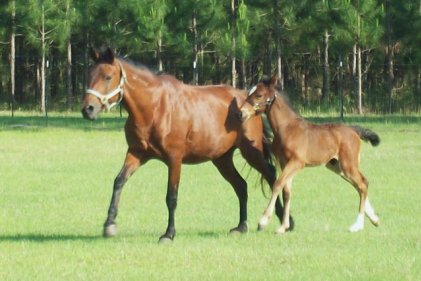How To Train A Young Rescue With Issues?
I have a two year old Appaloosa quarter horse named Ginger that I rescued from an animal hoarder. She has over 17 horses and puts out feed and lets them fight for their feed. My horse has a food aggression because of this, but now is starting to calm down since she knows no one will take her feed. She has never had a bath, a farrier, or her hooves cleaned. She also has never been broken.
I have saddled her up and gotten on her with no problem, I was amazed. Since she’s not broken, when I ride her, instead of going foward she goes backwards in circles. She is clueless on going foward, I’m not sure what to do. All my friends are baffled.
I’m having some other baffling problems with her other than her riding. I’m keeping her at a barn with my friend’s two horses, an 8 year old gelding and an 18 year old mare. She gets along with the mare, but she will always attack and is just mean to her gelding. But the baffling thing is, she is only mean when he is in a stall with her. She goes crazy and kicks him. But anywhere else she is fine. My trainer says it’s because shes never been put in her place but I’m not sure how to do that.
She has also been very defensive these past couple of days and has been trying to kick me. The person I rescued her from just told me to sell her to slaughter because she’s too much. She is still a baby and I’m willing to do whatever I can. Any advice on her behavior and riding issues?
Also I have tried lunging her but she does not like it at all, it seems to make it all worse. Any other techniques to get her energy out? Thank you.
Thank you for your email to CowgirlDiary.com. I will attempt to offer you some personal advice, but must preface it by saying that because of Ginger’s issues, it would be best for both you and her if you had some hands-on help from a professional trainer. I understand that you may not want to spend the money, but please realize that you could be putting yourself in harm’s way with a horse of this type, and just a simple email answer will likely not solve Ginger’s problems. She needs to be worked with by a professional until she has developed some respect and better handling habits.
That being said, I will try to answer your questions one by one. Just be very careful around her, since she has the kicking tendency. She won’t get trained very well if you are in the hospital or on crutches, so please be cautious.
1. As far as the food aggression, I would suggest leaving her entirely alone when she’s eating. Don’t feed her by hand, and if she is pushy when you walk in with a feed bucket, take a crop with you and don’t be shy about demanding your own personal space. A horse that will walk all over you to get its feed is a danger, it will affect her manners in all other aspects including riding, and will make her a low-value horse. If she comes into your space or doesn’t step back when you approach her feed pan to pour the feed in etc., use a verbal command (this is a REQUEST to the horse, a nice way of asking it to move) such as “ck-ck-ck” clucking sound with your tongue, to ask her to step back or move away from you. If she continues to barge towards you or otherwise ignores your request, then you give her a body language command (your free arm that’s not holding the bucket should be holding a crop or lunge whip or stick…if you have none, at least raise your hand to the horse’s eye level, and as a horse will instinctively protect its eyes by ducking away or back, wave your arm and use a strong angry voice to say “BACK! Get BACK!”–this is a DEMAND to the horse, a not-so-nice way of telling her that she disobeyed your first command and is about to get in big trouble.) If she is still insensitive to either your request or your demand, you must take physical action to get her to respond. This could be a whack in the chest or neck area with your crop, or a hard elbow jab to the shoulder area if she is that close to you and you don’t have a crop. At this point, you must do anything you can to get her to give ground. If she doesn’t learn to move back when you ask her kindly, tell her bluntly, and then have to whack her, then she is an extremely dangerous animal and you shouldn’t be going into her pen. So work on these steps to improve her handling manners.
2. The walking backwards thing when you get on her is also a huge problem. Horses that refuse to move forward are more likely to rear up and even rear over backwards and can crush their rider. Again, in this situation, you must do anything you can to get her to move forward. She may be acting confused, but this backing up action is still a refusal to do what she is asked, and it must be addressed. I would suggest not riding her at all until she will lunge perfectly and obey your ground commands.
3. So train her to lunge. You can read my advice on lunging at either of these two articles: Lunging Advice
Training Your Horse To Lunge
I would guess that your biggest issue with Ginger not wanting to lunge is that she is refusing to move away from you in a circle. You mentioned “she does not like it at all” and “it seems to make it all worse”. This is because you feel “mean” making her go away from you. But it has to be done, if she is going to become a dependable, safe, respectful riding horse. I understand that it is not appropriate to beat your horse, or whip a horse unmercifully. But when training horses, you must learn to speak their language. Understand that in a horse herd, if the dominant horse tells a younger horse to submit or move away from them, the younger horse may not understand at first, but a few well-aimed kicks later, or a bite on the neck, and that young horse knows EXACTLY what to do! It’s the same when you are working with Ginger. Be sweet as long as she is obedient. Become a raging monster the minute she disobeys. She will get the idea, and you don’t have to actually hurt her to get her attention.
To get her to move forward and around you on the lunge line, position yourself with the lunge line in your left hand for a left circle, right hand for a right circle; point the way with the lunge line hand, and use the other hand with the lunge whip in it to encourage her, or drive her, into movement. First ask (a vocal signal–I use a “ck-ck-ck” sound with my tongue, this always means “move forward”) and if she doesn’t move as asked, then demand (a body language signal–raise the lunge whip behind her but, make your voice stronger and louder, swish the whip near her heels) and if she still doesn’t move, then make her move (give her a good slap with the lunge whip on the hindquarters…always make sure you keep the whip behind her withers, and be ready for her to jump forward or away, try to work her into a circle.)
She will most likely stop and try to face you or look at you. Repeat the above steps in a steady manner, ask (“ck-ck-ck”), demand (body language), and then MAKE her go. Repeat for twenty minutes every day, and she will be lunging perfectly.
When she will lunge, you are now closer to being able to ride her. Ask a helper to give her the lunging cues while you are on her back. She should move forward willingly if you have done all the work in teaching her to lunge.
4. Her herd behavior to the gelding is completely natural and cannot be remedied by anything you do, other than separating them. Horses usually establish their order of dominance, and that is all she is doing, it’s natural. If she is picking on him to the point that he cannot eat or is getting skin ripped off him, then you might consider putting him or her in their own pen. Do they have to share a stall? I would definitely feed them separately, or the gelding will not be able to get the feed he needs. And I wouldn’t stall them together. It would be better for one of them to stay outside than for the gelding to get beat up every night. As far as putting the mare in her place, that’s something only the gelding could do (you interfering won’t make Ginger think any differently towards him) so I wouldn’t worry about it.
5. As far as kicking, I think the lunging will help, as it will show her that you are dominant over her. Also, don’t let her turn her hind end towards you in a threatening manner. For instance, if you go out to catch her and are approaching with the halter and lead rope in your hand and she turns her tail and pins her ears, throw the halter and lead rope at her hind end as hard as you can fling it. You won’t hurt her, but it will hopefully scare her a little and she should turn and look at you, like, “What in the world?” Any time she acts like she’s going to kick, move to a safe distance but try to scare her or swing something at her hind end, it will make her turn around and face you to see what you just did. Then when she faces you, say, “Good girl!” and talk nicely to her and hold out your hand to pet her. You want a horse to face you when you’re trying to catch it, not turn its butt. You can also kick dirt at her if she turns away. Or use a lunge whip or training stick with a plastic bag tied to the end of it, anything to scare her when she turns her heels. Don’t allow this bad behavior in her.
I hope this advice has been a help to you. I think you have gotten her young enough to make a big difference in her life, and she will turn out just fine. But at the beginning you need to prevent her from forming bad habits. If you are strict with her, she won’t fear you (don’t be afraid to smack her if she ignores your request followed by your demand), but she will learn that you mean it when you say something, and soon just the request will be all she needs to obey quickly and quietly. This is the end goal….getting there isn’t always fun, but it’s SO important!
Thanks for asking for my advice, and feel free to write again or comment on my blog anytime.

